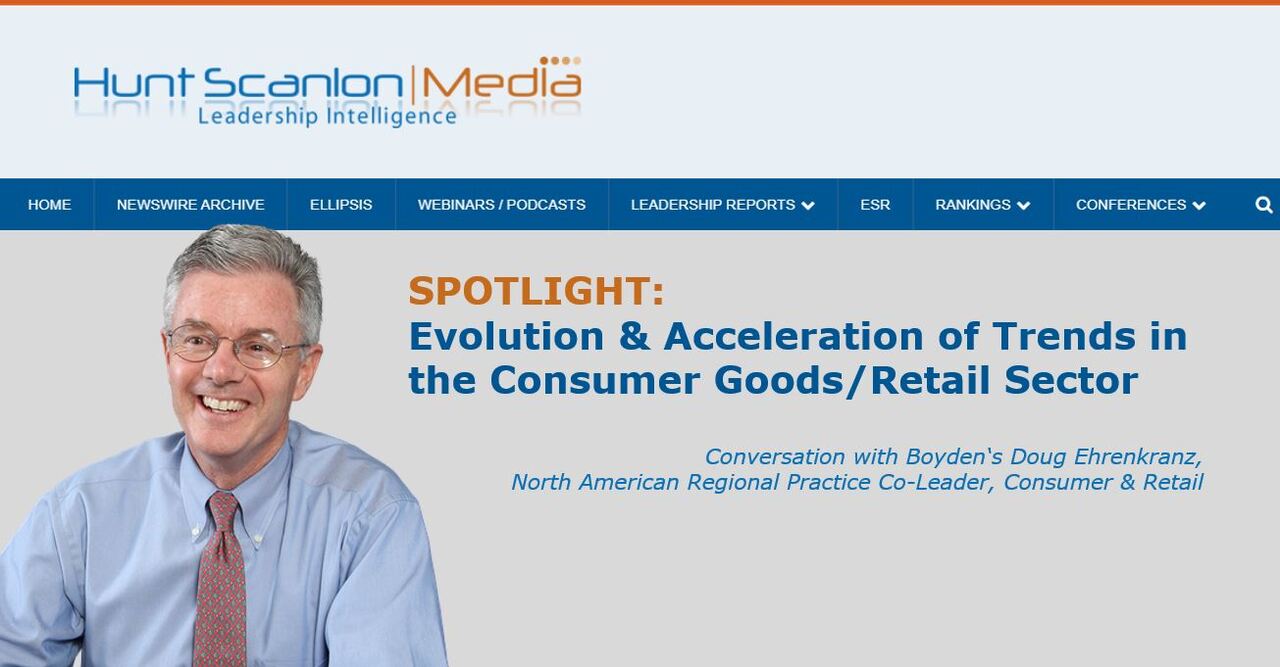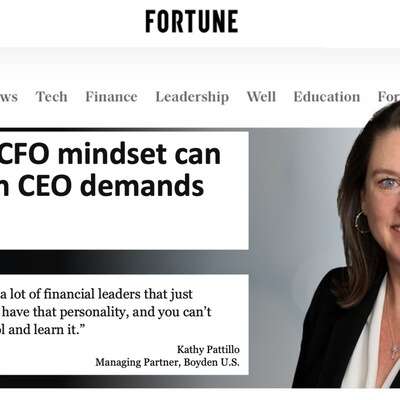Boyden's Doug Ehrenkranz recently sat down with Hunt Scanlon Media to discuss some trends in the retail sector
This article was originally published on Hunt Scanlon Media's website. Click here to view the original article.

Doug Ehrenkranz is the North America regional practice co-leader – consumer goods and retail practice at Boyden. His focus is on the consumer goods, CPG, retail, and industrial sectors, including oilfield and industrial services, chemical, and food ingredients, mainstream food and beverage, durables and health and beauty products, as well as natural and organic. Mr. Ehrenkranz leads searches for C-level, VP, director and other roles in a range of disciplines: general management, sales, marketing, business development, operations, manufacturing, supply chain and logistics. He works with Fortune 500 companies; mid-sized and smaller companies; and publicly held, private equity, private and founder-led companies, including start-up and early stage companies. Mr. Ehrenkranz recently sat down with Hunt Scanlon Media to discuss some trends in the retail sector.
Doug, how has the retail sector changed over the years?
Even before the pandemic, there was significant change unfolding in the consumer goods/retail sector. If anything, the pandemic simply accelerated the pace of change. That said, several things evolved specifically due to the pandemic, and they may be here to stay. For example, the executive-level leadership landscape was already shifting before the pandemic, and that movement was then hastened by the pandemic. With a changed retail landscape, retail and consumer goods companies across the board are assessing their senior leadership needs and taking the steps to get the right talent in place. Three functional areas which are in critical need of leadership right now include supply chain, E-commerce and human capital management, and transcending across all functions is the emergence of ESG (environment, sustainability and governance) as a necessary imperative.
What role has artificial intelligence played?
Artificial intelligence is one of the most significant technology drivers that is affecting every conceivable aspect of the retail industry, from the front-end initial consumer experience on websites to demand forecasting and logistics on the back-end, and everything in between. This has been the case for many years now, but with the pandemic-related increase in reliance on technology, its presence has become even more relevant to this sector. With AI assistants like Alexa, consumers can ask a machine to compare prices, make suggestions, and place orders from their homes, rather than go to the store and buy brands that they would typically remember and prefer. This means increased competition between brands. When the shutdown occurred, consumers became accustomed to this way of shopping, and it is very unlikely that they will be willing to surrender that convenience post-pandemic. This means that marketers may have to increasingly target devices rather than consumers.
What affect has the pandemic had on the sector?
Post-pandemic macrotrends, like working from home, have affected the consumer goods and retail sector heavily and may have permanently changed how and where we work. According to a recent survey from EmploymentHero, 55 percent of remote workers said that they would look for another position if the remote work option was taken away. So, for many companies a hybrid working environment may make sense over the long term. The ripple effect through the commercial real estate sector is obvious. Of course, one cannot bring up remote work during the pandemic without also discussing how in-home video conferencing has likely forever changed the way we interact with colleagues, customers and clients. Zoom, for example, grew from a relatively unknown company to a household name in under a year. Who ever imagined “zoom” would become a verb.
How have employees working from home impacted the sector?
The work-from-home dynamic is causing a ripple effect on the retail and consumer goods sector (think changes in apparel when working remotely, at-home meals vs. eating out with clients and coworkers, decrease in travel and lodging, changes in personal grooming...the list goes on and on). Retailers face significant challenges in the months and years ahead, as they must adapt to consumers’ new habits that developed as a result of the pandemic. For example, keeping the option of contactless shopping and curbside pickup available, even as stores begin to reopen. In a recent GlobalData survey, 68 percent of U.S. shoppers say they plan to continue using curbside pickup at stores in the future, and 60 percent plan to continue making online purchases and having them either shipped to their homes or picking them up at the store when their order is ready. This shift is changing the way stores use their employees; both Walmart and Target report that they are now cross-training in-store employees to have a wider variety of duties, thus allowing them to fill the large amount of online orders and curbside pickup.
Discuss the disruption of the supply chain.
One of the most significant and costly changes that has come about for both companies and consumers is the disruption of the supply chain. This disruption was already underway well before the pandemic, due to the government’s tariffs on some goods from China. That, compounded with the pandemic and its far-reaching impact, has resulted in a variety of macro and micro issues. There have been resulting shortages of an endless variety of products, including aluminum cans, lumber, shipping containers, dozens of food commodities, bicycles, resins and even pets. The breakdown of the supply chain has also caused inflation to reach levels that haven’t been seen in decades. According to a recent report from Forbes, many retailers don’t anticipate an acceptable supply chain recovery until the summer of 2022, possibly even later.



